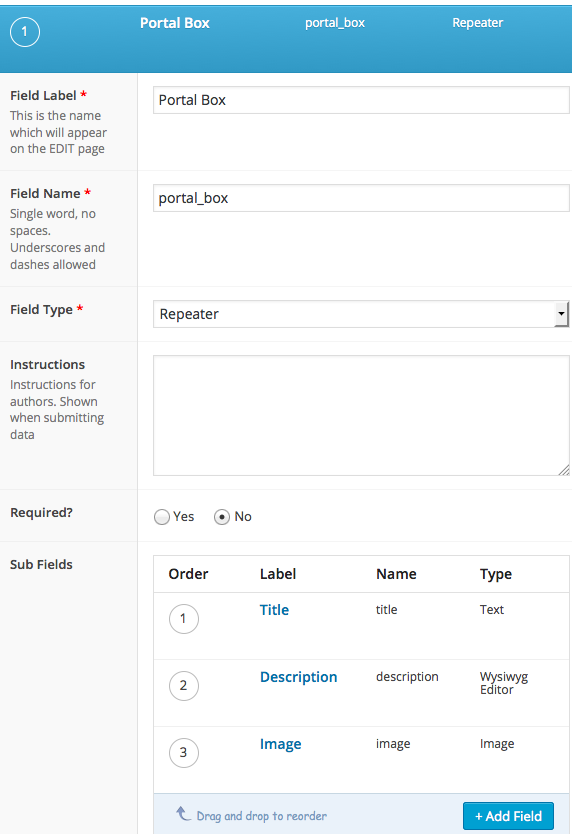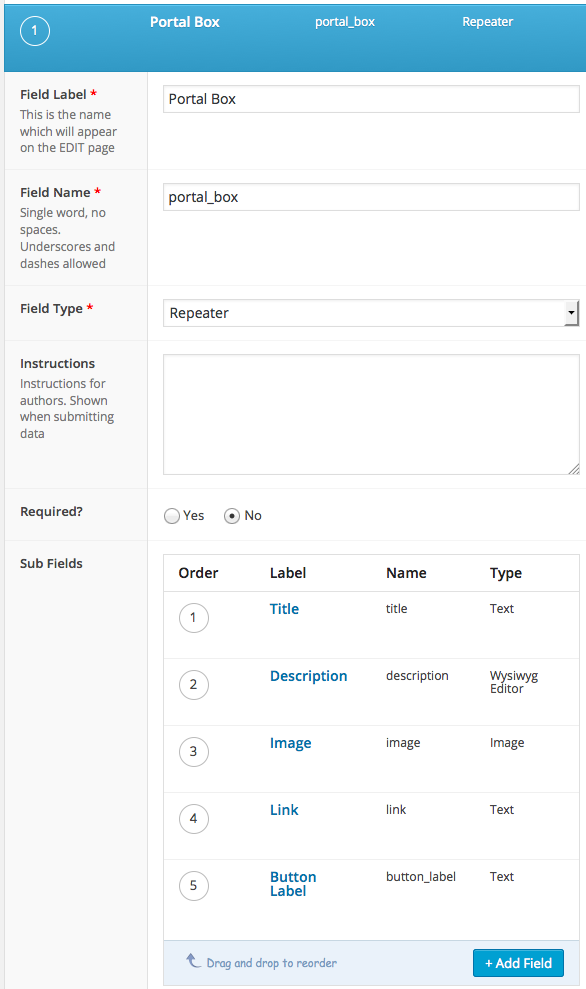Search Results for 'q'
reply
-
In reply to How can I apend code before and after image?
- June 7, 2015 at 6:31 am
-

In reply to Responsive background images
- June 6, 2015 at 10:32 pm
First question I have is, what will you use to put responsive background images into the backgrounds. I’m curious because I was recently looking for some way to do this and didn’t find anything. I had to settle for using https://github.com/scottjehl/picturefill which requires an
tag so I had to insert the images into the content.
The way I did this was that I provided the client with the ability to upload alternate images cropped at different sizes and I built the
tags dynamically.
-

In reply to Pull City out of Address Field
- June 6, 2015 at 8:44 pm
Trying to clear up some old topics. This question appears to be about an add on for ACF that was created by someone else and is no longer supported.
This can be easily accomplished by created several text fields, and or select fields if you wanted to get fancy with state/country fields instead of having a single field to hold everything.
-

In reply to Displaying a relationship field only if it exists
- June 6, 2015 at 8:34 pm
I know this is an old question and the OP may not still be looking for help, but someone may have the same question.
Using the above code to work from:
global $post; $posts = get_field('doctors'); if ($posts) { foreach ($posts as $post) { setup_postdata($post); $name = get_field('doctor_name'); if ($name) { $field_object = get_field_object('doctor_name'); echo $field_object[label],': ',$name; } } // end foreach wp_reset_postdata(); } // end if posts -

In reply to Add Instructions to Options Page
- June 6, 2015 at 7:34 pm
Not a problem, I’m just trying to help out with clearing up questions here on the support forums and it was something I could answer.
-

In reply to Is it possible to set up Option fields per "page"
- June 6, 2015 at 10:07 am
I know that this is an old question and you may not need help with it at this point, but someone else may be looking for similar information.
What you want to accomplish is possible to do before you get to the content. In your header.php files you can do something like:
$queried_object = get_queried_object(); if (isset($queried_object->ID)) { $post_id = $queried_object->ID; $field_value = get_field('my_field', $post_id); } -
In reply to Adding an Image with a “Choice” field
- June 6, 2015 at 8:24 am
Thank you for your help. I ended up just using a true/false custom field with an if/else statement. Being it was only on one custom post type I just added the php in post type.
<?php if( get_field('image4') ) { echo "Photo's taken by: <a href='http://www.sample.com/'><img src='http://photolinkhere.jpg' /></a>"; } else{} ?> -

In reply to Adding an Image with a “Choice” field
- June 6, 2015 at 12:49 am
After some more thought, you could add custom fields to the image attachment itself.
Location: Attachment : is equal to : all
and then you can use the attachment id to get the data for the specific image. More information is here: http://www.advancedcustomfields.com/resources/how-to-get-values-from-a-media-attachment/ specifically the section on “Retrieve from another image custom field”
-

In reply to Is my field/data structure correct?
- June 5, 2015 at 9:35 am
Question one:
That’s the easiest and fastest way to do it using fields. On the other hand, you could create a custom taxonomy that is hierarchical and then at the top level create the states and then on the second level you could have counties.
To do it with fields so that only the counties you want are loaded would take a lot more work, you’d need to create some custom javascript to reload the county select field whenever the state field was changed. Possible, but takes longer and the result from the users perspective will be the same.
Question 2:
I would also carefully name my county fields. If you are using the state abbr for the value of state then:
ia_county, nm_county, etcthen you can simplify getting the county
$county_field = $state.'_county'; $county = get_field($county_field) -
In reply to Update to ACF Pro makes themed fields disappear
- June 5, 2015 at 8:03 am
I don’t think they worked. I had to start over the migration due to a Mysql error and saw again at the 4.4.2 point the renderings are blank (although the data remains visible on the edit side).
-

In reply to Order by subfield values
- June 5, 2015 at 6:07 am
WordPress 4.2 introduced new order by clauses for meta_query.
https://make.wordpress.org/core/2015/03/30/query-improvements-in-wp-4-2-orderby-and-meta_query/
Which would probably let you do what you looking for.
By the way, very good solution for altering ‘meta_key =’ to ‘meta_key LIKE’. I know I”l be using that in the future.
-

In reply to Using a front-end CPT creation form on a CPT page
- June 5, 2015 at 5:48 am
I’m assuming that this question is related to the other question and if we answer that one we’ll also answer this one.
-

In reply to Create a table of field values of all posts of a custom post type?
- June 4, 2015 at 9:27 pm
The only way I know of to do a query for the posts, create a table and then loop through the posts and create the table. You’ll probably need to create a custom page template if you want to do this, or alternately on a custom post type archive page.
The get_fields() function can get all the fields at once rather than getting them one at a time, may help if you have lots of fields to retrieve. http://www.advancedcustomfields.com/resources/get_fields/
-
In reply to 'source code' button on wysiwyg editor field
- June 4, 2015 at 5:46 am
Hi, I don’t think the tinymce editor is created by another plugin. I’m just using ACF’s own Wysiwyg Editor fields. I’ve attached two screenshots to illustrate the problem:
Its hard to edit code with no formatting like that. I’d like the line breaks and indentation of the code.
-
In reply to duplicat fields after upgrading to PRO
- June 4, 2015 at 4:21 am
We just had the same problem with a transition from ACF+Repeater, etc., to Pro. All our field groups but one were duplicated. The one that was not duplicated had only a single text field; each of the others had repeater, WYSIWYG and/or related post link fields.
The bad news is that in at least one case, there are two fields missing from one of the repeater fields in the older version of the field group. The portal_box field in field_group #5209 has only three fields; the one in field_group #5255 contains all five of the fields that should be there. (See attachments.) As a result, part of the portal box is not displaying.
We have no multi-language support. Here’s a list of our active plugins:
ManageWP – Worker (v4.1.6) by ManageWP
Gravity Forms (v1.9.9) by rocketgenius
Admin Quick Jump (v1.4) by James Kemp
Advanced Custom Fields Pro (v5.2.6) by elliot condon
Advanced Post Types Order (v3.6.2) by Nsp Code
BackWPup (v3.1.4) by Inpsyde GmbH
Categories Images (v2.5) by Muhammad Said El Zahlan
Cookies for Comments (v0.5.5) by Donncha O Caoimh
Duplicate Post (v2.6) by Enrico Battocchi
WordPress Editorial Calendar (v3.5) by Colin Vernon, Justin Evans, Joachim Kudish, Mary Vogt, and Zack Grossbart
Enable Media Replace (v3.0.3) by Måns Jonasson
Google Analytics by Yoast (v5.4.2) by Team Yoast
Google Calendar Events (v0.7.2) by Ross Hanney
Gravity Forms – Placeholders add-on (v1.2.1) by Joan Piedra
Gravity Forms MailChimp Add-On (v3.6) by rocketgenius
Image Watermark (v1.5.0) by dFactory
McWebby Magnific Popup (v00.01.00) by Donna McMaster
McWebby Custom Post Types (v00.02.01) by Donna McMaster (declares post types)
Media Tags (v3.2.0.2) by Paul Menard
Members (v0.2.4) by Justin Tadlock
Simple Sitemap (v1.65) by David Gwyer
Sucuri Security – Auditing, Malware Scanner and Hardening (v1.7.9) by Sucuri, INC
Category Order and Taxonomy Terms Order (v1.4.2) by Nsp-Code
ThreeWP Activity Monitor (v2.12) by edward mindreantre
WooCommerce Bulk Discount (v2.3.1) by Rene Puchinger
WooCommerce Dynamic Pricing (v2.9.6) by Lucas Stark
WooCommerce (v2.3.10) by WooThemes
WooThemes Helper (v1.5.5) by WooThemes
WordPress SEO (v2.1.1) by Team Yoast
WP Migrate DB Pro (v1.4.7) by Delicious Brains
WP SEO Humility (v0.1) by Donna McMasterMust-use Plugins:
ManageWP – Worker Loader (v) by ManageWP
McWebby Debug Log (v0.1.0) by Donna McMaster -
In reply to Order query based on relationship
- June 4, 2015 at 2:20 am
Well i’ve skipped using ACF for now until I get a response but FYI, I done it using the following:
function sytycdv2_posts_clauses($pieces) { global $wp_query, $wpdb; if (preg_match("/post_type = '([^']+)'/", $pieces['where'], $matches) && !is_admin() && in_array($matches[1], get_campaign_post_types())) { $pieces['fields'] .= ", COALESCE((SELECT CASE WHEN COUNT(p99.ID) = 2 THEN 1 ELSE 0 END FROM {$wpdb->posts} p99 INNER JOIN {$wpdb->postmeta} pm99 ON (p99.ID = pm99.post_id) WHERE p99.post_type = 'campaign' AND (pm99.meta_key = '_start_date' AND (CAST(pm99.meta_value AS DATETIME) IS NULL OR CAST(pm99.meta_value AS DATETIME) <= NOW())) OR (pm99.meta_key = '_end_date' AND (CAST(pm99.meta_value AS DATETIME) IS NULL OR CAST(pm99.meta_value AS DATETIME) > NOW())) GROUP BY p99.ID HAVING COUNT(p99.ID) = 2 AND FIND_IN_SET(p99.ID, pm98.meta_value) LIMIT 0, 1),0) AS s"; $pieces['join'] .= " LEFT JOIN {$wpdb->postmeta} pm98 ON (wp_posts.ID = pm98.post_id AND pm98.meta_key = '_campaigns')"; $pieces['orderby'] = 's DESC, ' . $pieces['orderby']; } return $pieces; } add_action( 'posts_clauses', 'sytycdv2_posts_clauses' );As dirty as it looks, the above basically uses a subquery to return all campaigns that are valid and then checks to see if that campaign ID exists in the current posts custom field.
If the value exists, the subquery will return 1 otherwise 0.
Then you can see I’m sorting by the subquery result followed by the original sort, allowing it to promote the ones I want at the top, followed by the original posts 🙂
DIIIIIIIIRTY yes, but it works for now.
-

In reply to Field to display Posts and filter then by the value of a Field?
- June 3, 2015 at 9:00 am
Elliot has created a tutorial about querying relationship field here: http://www.advancedcustomfields.com/resources/querying-relationship-fields/
This would be a bit different. A Post Object field holds a single value rather than an array, so this makes it easier. Basically you just need to query the tasks post type with a meta_query to look for the ID of the project.
-

In reply to Request – help with up/downvote feature on relationship field
- June 3, 2015 at 2:35 am
So, this is not a 100% ACF solution, I don’t think that’s possible, and this is just an outline.
To store the vote value use a custom field, you would create a custom field for each collection that an item is in. I would make these hidden meta fields by adding an underscore at the beginning. For example if $collection holds my collection post my meta key would be
'_'.$collection. Then you simply store the current value in this field.I personally would only store the total from the up votes and down votes, for example each item in the collection would start off with a value of 0. up votes would increase it and down votes would decrease it. I would also use the second option because it will allow me to order the posts easier.
The next step is to create these custom meta fields in the first place. Create a acf/save_post filter as outlined here: http://www.advancedcustomfields.com/resources/acfsave_post/
This filter would run on your collection post type when the collection was saved.
1) Get the posts of the second post type from the relationship field
2) Test to see if the post in the collection has a value set for the custom field for this collection
3) If there is not an existing value then initialize it by created the field and setting it to 0.Now, when someone votes one way or another you can update this value. I’m assuming you might be using some type of AJAX to do this.
WordPress has recently added functionality that will let you order by these values in a more complex way when doing a query. The following are the meta queries and orderby that you could use.
$meta_key = '_the_collection_field_key'; $clause = $meta_key_clause.'_clause'; $meta_query = array( 'relation' => 'AND', $clause => array( 'key' => $meta_key, 'compare' => 'EXISTS', 'type' => 'NUMERIC' ) ); $orderby = array( $clause => 'ASC' );The above meta and orderby values uses the new meta clause feature added in WP v4.2. You can read more about it here: https://make.wordpress.org/core/2015/03/30/query-improvements-in-wp-4-2-orderby-and-meta_query/
I hope this helps. Like I said it’s only an outline and except for the save post filter, really does not involve ACF. This is definitely a situation where some custom coding is going to need to be done and not really a small project.
-

In reply to Frontend Form Tutorial
- June 3, 2015 at 1:23 am
Hi @iphoenix ,
Thanks for the request.I will let the developer know if this and probably might come up with a tutorial for the same.
-

In reply to Can't display data on post
- June 3, 2015 at 12:40 am
Hi @brian-w
Here is some sample code that may help in displaying custom post types in your page<?php $args = array( 'post_type' => 'products', 'post_status' => 'publish', 'posts_per_page' => '10' ); $products_loop = new WP_Query( $args ); if ( $products_loop->have_posts() ) : while ( $products_loop->have_posts() ) : $products_loop->the_post(); // Set variables $title = get_the_title(); $description = get_the_content(); $download = get_field(‘download’); $featured_image = wp_get_attachment_image_src( get_post_thumbnail_id(), 'full' ); $product_image1 = $featured_image[0]; $product_image2 = get_field(‘product_image’); // Output ?> <div class=”product”> <img src=”<?php echo $product_image1; ?>” alt=”<?php echo $title; ?>”> <h2><?php echo $title; ?></h2> <img src=”<?php echo $product_image1; ?>” alt=”product-detail” class=”product-detail align-right”> <?php echo $description; ?> <p><a href=”<?php echo $download; ?>” target=”_blank” name=”Spec Sheet”>Download Spec Sheet</a></p> </div> <?php endwhile; wp_reset_postdata(); endif; -

In reply to get_field('galery') return false
- June 2, 2015 at 11:42 pm
what code do you use to display the gallery? and what is your gallery-fieldname?
gallery is an array, that means you need a foreach loop like this to show the images inside that array:<?php $images = get_field('gallery'); if( $images ): ?> <ul> <?php foreach( $images as $image ): ?> <li> <a href="<?php echo $image['url']; ?>"> <img src="<?php echo $image['sizes']['thumbnail']; ?>" alt="<?php echo $image['alt']; ?>" /> </a> <p><?php echo $image['caption']; ?></p> </li> <?php endforeach; ?> </ul> <?php endif; ?> -

In reply to Conditional logic should work with 'post object' relational fields
- June 2, 2015 at 10:03 pm
Hi @nathanshubert,
Thank you for the feature request. This will be forwarded to the developer for consideration.
-

In reply to Query Posts using meta data from a Post Object field
- June 2, 2015 at 9:15 pm
Hi @quirksmode
This is achievable through the use of the acf/fields/post_object/query filter. You can modify the $args array as follows:
function my_post_object_query( $args, $field, $post ) {
$args[‘author’]=$user_id
return $args;
}add_filter(‘acf/fields/post_object/query/name=my_post_object’, ‘my_post_object_query’, 10, 3);
For more info you can refer to this article: acf/fields/post_object/query
-

In reply to ACF and Polylang
- June 2, 2015 at 6:27 pm
-

In reply to Flexible content field suddenly gone after edit
- June 2, 2015 at 5:52 pm
Welcome
Welcome to the Advanced Custom Fields community forum.
Browse through ideas, snippets of code, questions and answers between fellow ACF users
Forums
Helping Others
Helping others is a great way to earn karma, gain badges and help ACF development!


